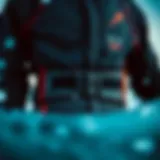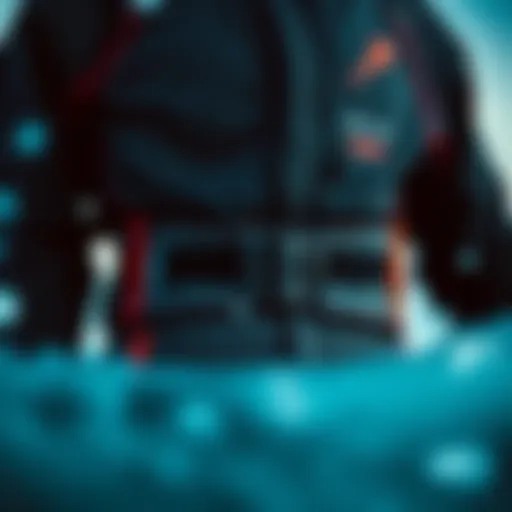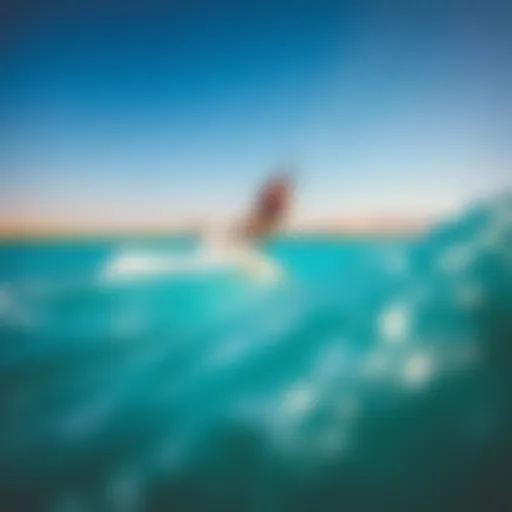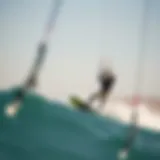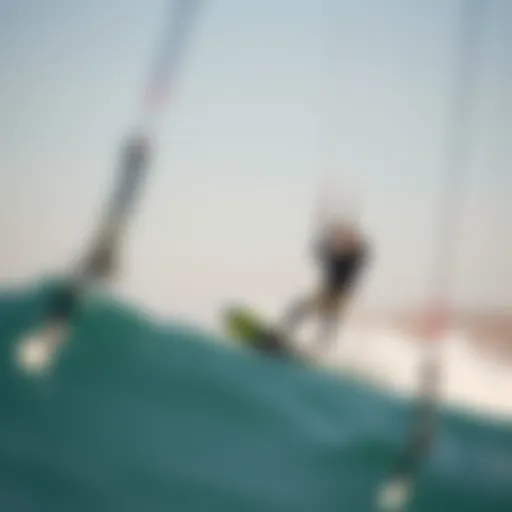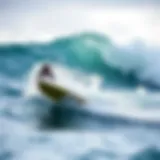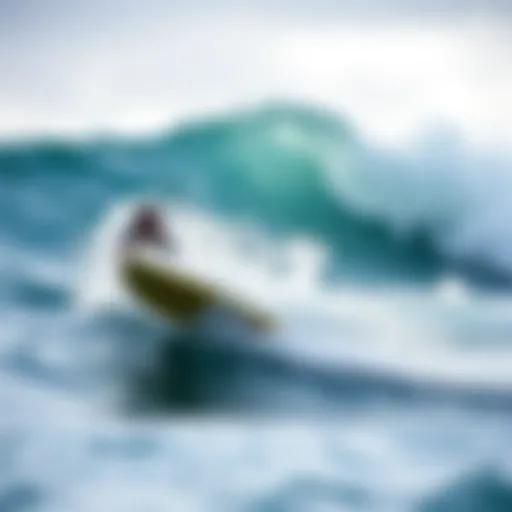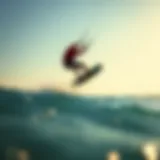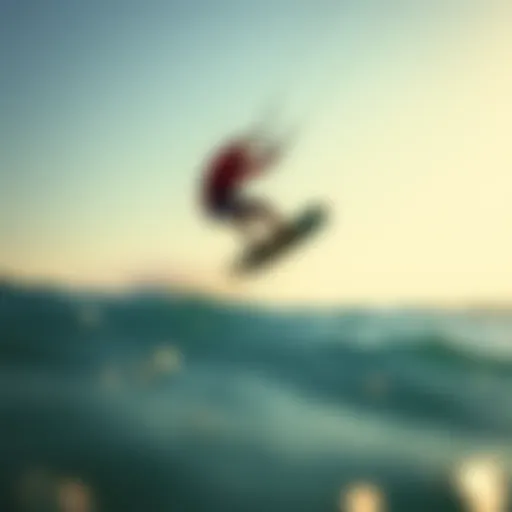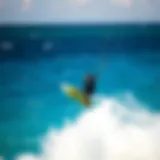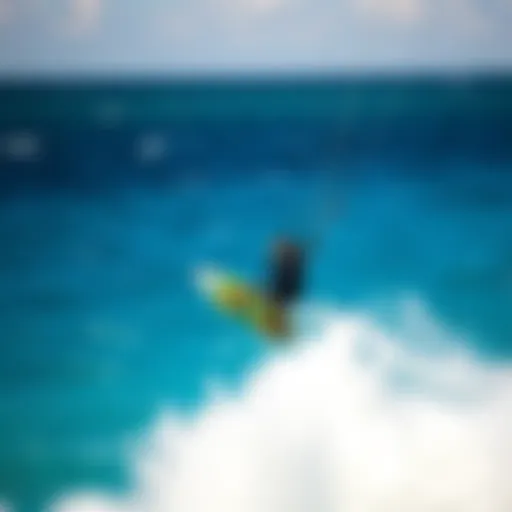Wings for Sale: Your Guide to Kiteboarding Equipment


Intro
Kiteboarding is more than just a thrilling sport; it’s a unique blend of finesse, adventure, and technical prowess. With the wind in your favor and the right gear, the open waters become your playground. A solid understanding of kiteboarding equipment, specifically the wings, is pivotal for enhancing your experience. This guide shines a spotlight on the various types of wings available on the market, essential features to look for, and guidance on purchasing. By equipping yourself with the right knowledge, you'll navigate the wide world of kiteboarding with confidence and ease.
Techniques for Kiteboarding Enthusiasts
Beginner Techniques
Starting out in kiteboarding can feel like stepping into the unknown. The first step is getting to grips with the basics of controlling your kite. Here’s a simple breakdown of what you should know:
- Understanding the Wind Window: The wind window is the area where your kite can generate lift. Spend time familiarizing yourself with this concept. It's crucial to be aware of where the power zone is located.
- Stance and Balance: Position yourself correctly on the board. Your feet should be shoulder-width apart, and your knees slightly bent. Balancing your weight is key to maintaining control.
- Launching and Landing: Learning the safe methods to launch and land your kite is fundamental. It's advisable to practice these skills with a buddy or instructor.
Remember that persistence is essential. Expect to practice these techniques until they become second nature.
Advanced Maneuvers
Once you’ve mastered the basics, it’s time to elevate your skills. Advanced maneuvers can set you apart from other kiteboarders. Here are a few to consider:
- Jumping: This involves using the kite’s lift to launch yourself into the air. Timing and kite control are key.
- Transitions: These allow you to change directions smoothly. A solid transition can flow seamlessly into tricks, making for a fluid ride.
- Waves Riding: Tackling the waves requires good timing and an understanding of how to use the kite’s power effectively.
Equipment Reviews
Kite Reviews
When selecting a kite, it’s all about personal preference and riding style. Popular options in the market today include the Duotone Nitro and the Cabrinha Switchblade. Both cater to different types of riders, from beginners to seasoned veterans, ensuring there’s a fit for everyone.
- Duotone Nitro: Known for its stability and ease of use, this kite is fantastic for those just getting started.
- Cabrinha Switchblade: Offers versatility and exceptional control, making it perfect for more advanced riders looking to perform tricks.
Board Reviews
Choosing the right board can significantly impact your performance. Brands like Liquid Force and Naish have standout options tailored to various conditions.
- Liquid Force Drive: Ideal for beginners, this board provides ample support and buoyancy on the water.
- Naish Motion: This board is favored among advanced kiteboarders for its agility and responsiveness in the waves.
With the vast options available, it’s crucial to test different equipment before making a final decision.
"The right equipment can make all the difference in your kiteboarding journey. It’s not just about being flashy; having equipment that suits your style enhances your safety and enjoyment as well."
Optimizing your skills and knowledge will lead to a richer experience on the water, whether for leisure or competition. For further insights, visit Wikipedia or engage with fellow kiteboarders on Reddit.
Understanding Kiteboarding Wings
When it comes to kiteboarding, wings serve as the heart of the experience. Understanding them is crucial for anyone keen on mastering this thrilling sport. Starting with the basics, kiteboarding wings are the sails that catch the wind, enabling adrenaline-fueled rides across the water. Their design, size, and materials greatly affect performance and overall experience. With the right information, you can choose a wing that not only suits your skill level but also enhances your time on the water.
In the realm of kiteboarding, it’s important to grasp how wings have evolved over the years, adapting to trends and technologies that shape the sport. As new materials have come into play, the effectiveness and durability of equipment have improved significantly. Coupled with the diverse variety of wings available today, understanding these elements can make a real difference in your kiteboarding journey.
The Evolution of Kiteboarding Equipment
The journey of kiteboarding equipment has seen drastic transformations over the decades. From the early days when makeshift materials would serve as wings, advancements in technology and design have led us to where we are now.
In the late '90s, the introduction of inflatable kites revolutionized the sport, allowing for easier handling and improved safety. Fast-forward to today, we’ve got a mix of foil, inflatable, and hybrid wings, each tailored to different styles and conditions. The materials used now range from ripstop nylon to high-performance plastics — crafted to withstand the elements while providing an exhilarating ride. These enhancements make understanding the evolution absolutely pivotal for potential kiteboarders, as it informs not just what to purchase, but also how to take full advantage of what’s available.
Types of Wings for Kiteboarding
When it comes to types of wings, kiteboarding offers a variety that caters to all preferences and skill levels. Each type has its unique traits that elevate the experience differently. Here’s a closer look:
Foil Wings
Foil wings have gained quite a following due to their sleek and streamlined design. These wings offer amazing lift, allowing riders to glide effortlessly above the water's surface. They are designed with a solid frame and a surface that utilizes hydrofoils for lift, generating speed even in lighter winds. A standout feature of foil wings is their ability to allow for longer rides with less wind, making them an appealing choice for seasoned riders looking for a new challenge.
However, they do come with a learning curve. Beginners might find them less forgiving, especially in choppy waters, which can lead to a steeper learning curve.
Inflatable Wings
The inflatable wings are like the bread and butter of kiteboarding. Designed for ease of use, they typically feature air-filled chambers that give them structure and stability. Their flexibility makes them popular with beginners and advanced riders alike. One key characteristic is their ability to deflate easily, allowing for compact storage and easy transportation.
While they’re generally more forgiving and stable compared to foil wings, they can be less efficient in very light winds, requiring higher wind speeds for optimal performance.
Hybrid Wings
Lastly, hybrid wings combine the best of both worlds. They incorporate elements from foil and inflatable wings, marrying their advantages into a single design. Riders appreciate their adaptability, as they perform well in varying conditions — from calm seas to choppy waters. A unique feature of hybrid wings is their versatility, appealing to a broader audience as they cater to diverse skill sets and conditions.
However, the complexity of hybrid designs can be a bit daunting, particularly for newcomers. It’s essential to weigh the benefits against your specific needs when considering a hybrid option.
In summary, knowing the types of wings can help you make educated decisions that align with your riding style, conditions you’ll face, and ultimately, how much enjoyment you’ll derive from your kiteboarding escapades.
Key Features to Consider
When it comes to kiteboarding, selecting the right wing is as crucial as choosing your board. The various key features can significantly affect your performance and overall experience on the water. Understanding these features means you can make educated decisions, important for both novice and seasoned riders alike.
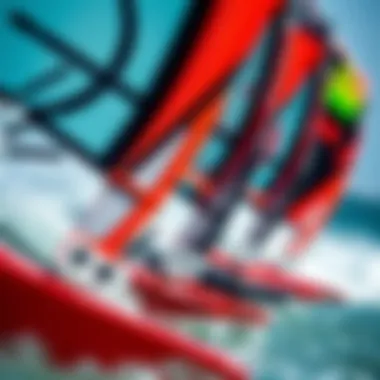
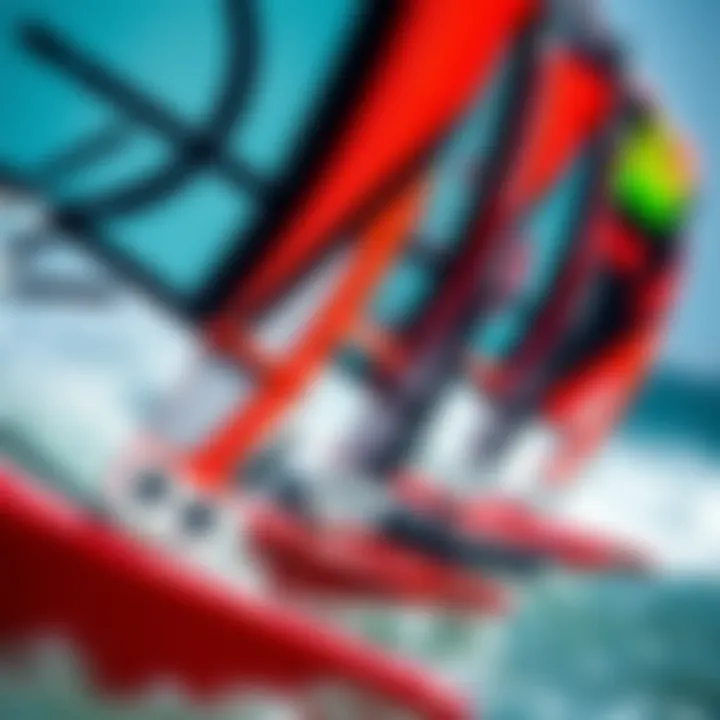
Wing Shape and Design
Aspect Ratio
The aspect ratio of a wing refers to the relationship between its width and its height. A higher aspect ratio wing is sleek and elongated, designed for higher speeds and better lift. These wings excel in performance as they reduce drag, making them a favored choice among experienced riders looking to maximize their potential. However, there's a trade-off; they can be less stable in turbulent winds. On the other hand, a lower aspect ratio provides better maneuverability and stability, which can be particularly beneficial for beginners navigating choppy waters.
Key characteristics of aspect ratio:
- Drag Reduction: Higher ratios often mean less drag, allowing for quicker speeds.
- Lift Efficiency: They can lift better, helping riders perform jumps and tricks with ease.
To summarize, an understanding of aspect ratios can help you decide on a wing that suits your style and skills.
Profile Design
Profile design refers to the shape of the wing when viewed from the side. This element plays a pivotal role in determining how the wing interacts with the wind. Wings with a deeper profile offer better low-end power, which is great for those tricky days with light winds. Conversely, a flatter profile might give higher speeds, useful in robust conditions.
The unique feature here is how it influences both power and control. A well-designed profile encourages smoother handling, making it a popular choice among riders seeking reliability under different conditions. It may, however, come at the cost of slower speed in optimal wind environments.
Materials Used in Construction
Durability Considerations
Durability can't be overstated when selecting kiteboarding wings. Various materials such as ripstop nylon or mylar contribute heavily to the wing's longevity. A robust fabric not only withstands harsh conditions but also resists tears and punctures, making your investment last longer. Riders often cherish wings that show minimal wear even after repeated use.
Some characteristics of durable materials include:
- Weather Resistance: Good materials resist UV damage and wet conditions.
- Lightweight Construction: Despite their strength, many durable fabrics remain light, essential for maximizing performance.
Ultimately, considering materials aids riders in selecting equipment that endures the elements.
Weight vs. Performance
Finding an ideal balance between weight and performance is vital for kiteboarding success. Lighter wings generally allow for quicker responses and less effort during maneuvers. However, if a wing is too light, it might lack stability in gusty wind conditions. This characteristic can make selecting the right wing feel like a tightrope walk: a featherweight for maneuverability versus a sturdier design for control.
Benefits of considering weight vs. performance include:
- Speed: Lighter wings accelerate faster, enhancing performance.
- Control: A heavier wing might perform stably during strong winds.
Therefore, weighing these factors will influence your choice depending on your riding style and preferences.
Size and Volume Matching
Beginners vs. Advanced Riders
The size of the wing, particularly its volume, plays a significant role for riders at different skill levels. Beginners typically benefit from larger wings that provide more lift and stability, making it easier to get started. These larger wings help in catching wind and staying afloat, giving newcomers a fighting chance as they work on their skills. For advanced riders, the preference leans towards smaller wings that grant enhanced performance and agility, allowing for more technical maneuvers.
Key points to note:
- Beginner: Larger wings offer easier handling and security.
- Advanced: Smaller wings enable more control, speed, and trick execution.
Understanding the size needed for your level will greatly affect your comfort and performance as you progress.
Wind Conditions and Environment
Matching your wing to the wind conditions is non-negotiable. For strong winds, you might opt for a smaller wing that can handle the gusts without becoming uncontrollable. In contrast, light wind calls for larger wings to ensure you can harness available winds effectively.
The characteristics to consider here include:
- Wind Resistance: Wings designed for strong winds often feature reinforced designs.
- Lift Characteristics: Larger wings capitalize on available lift in lighter winds.
By understanding wind behavior and selecting wings accordingly, kiteboarders can prepare for many riding scenarios.
Performance Metrics
Understanding performance metrics in kiteboarding is crucial for any rider aiming for excellence in maneuverability and enjoyment on the water. These metrics directly influence how effectively a rider can harness the wind to achieve their riding goals. When selecting a wing, riders must pay close attention to specific elements, such as lift, control, and stability, as these factors can enhance or detract from the overall experience.
Lift and Power Delivery
Lift is the fundamental force that enables a kite to rise, allowing riders to glide smoothly across the water. The power delivery of a wing speaks to how well it translates wind energy into lift. Riders should look for wings designed to maximize lift through optimal shape and size. A well-designed wing will create a balanced lift that suits various riding styles; too much power can overwhelm beginners, while seasoned riders might seek that extra punch to perform advanced tricks.
Riders intending to progress to higher levels need to understand how lift changes with varying wind conditions. A wing that offers dependable lift under both gusty and steady winds can be a real game-changer. Moreover, the agility with which the wing delivers power aids in swift transitions during rides, providing that much-needed edge against unpredictable weather.
Control and Responsiveness
Control plays a pivotal role in how effectively a rider can navigate through various conditions. A responsive wing will react quickly to riders’ inputs, allowing for sharp turns and precise adjustments. Riders should consider wings that provide a direct connection between the wing and the rider's movements.
Considerations for Control:
- Input Timing: An effective wing should respond readily to finesse in control inputs, allowing for rapid maneuvers when necessary.
- Bar Feedback: The feedback from the control bar can tell a rider a lot. A wing with good tension will convey the wind's strength accurately, making adjusting to conditions much simpler.
- Profile Design: The aerodynamic profile of a wing significantly influences responsiveness. Riders should look for wings that cut through the air efficiently, allowing for sharper responses and better handling.
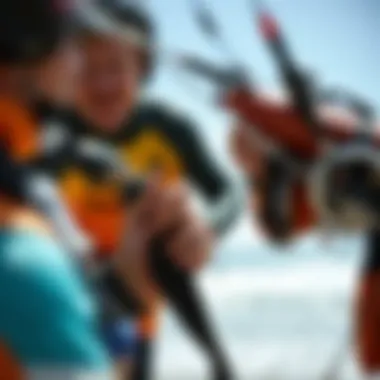
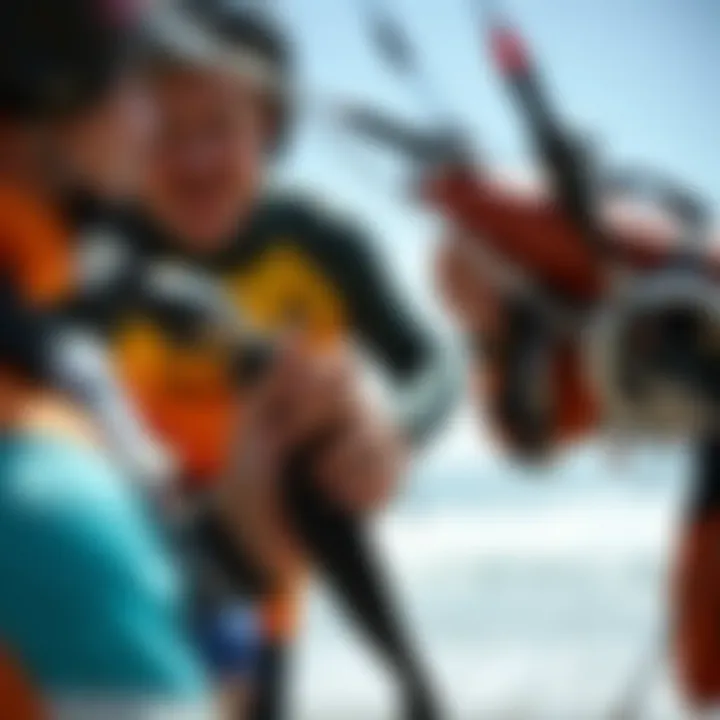
Stability in Different Conditions
Stability refers to a kite's ability to maintain its position in varying wind and wave conditions. A stable wing enables smoother rides, especially in choppy waters or during wind shifts. Riders should seek wings that are engineered for stability, offering enhanced control when the water turns less forgiving.
When it comes down to stability, several factors come into play:
- Wing Shape: A well-balanced wing shape contributes to stability. For instance, foil wings often excel in this area due to their design, accommodating various conditions seamlessly.
- Material Count: The materials used in constructing the wing also factor into its steadiness. A wing built from durable yet lightweight materials tends to perform better against unpredictable gusts.
- Rider Experience: More experienced riders might handle lack of stability better than novices. Still, a well-stabilized wing will allow beginners to focus more on technique rather than grappling with their equipment.
Stability is not just about control; it also instills confidence in inexperienced riders, encouraging them to explore new techniques and styles.
"Having a stable wing is paramount; it frees up mental energy that can be channeled into enjoying the ride while pushing sculpted limits of what they can do."
In summary, understanding performance metrics is not merely for technical knowledge but serves to enhance rider safety and enjoyment. By paying attention to lift, control, and stability, kiteboarders can develop deeper connections with their wings and elevate their riding experience.
Buying Guide
When it comes to selecting a kiteboarding wing, having a solid buying guide in hand can be your greatest ally. Knowing how to navigate the whirlwind of choices out there can greatly influence your experience, especially for those just stepping into the sport or seasoned riders looking to upgrade. This section aims to shine a light on vital considerations that can help you make an informed decision, avoiding common pitfalls that could sour your adventures on the water.
Where to Purchase Kiteboarding Wings
Online Retailers
Online retailers have ushered in an era of convenience that kiteboarding enthusiasts can appreciate. The sheer variety they offer is often unparalleled, making it easy to find exactly what you need at a few clicks. Whether it’s specialized online stores like Kiteboarding.com or larger platforms like Amazon, the options seem endless.
One key characteristic of these retailers is their user-friendly interface, which often comes with detailed customer reviews. This feature allows potential buyers to gain insights into the experiences of fellow kiteboarders, sometimes illuminating features that might not be immediately apparent. Plus, online retailers tend to have larger stock levels, making it simpler to snag that last-minute order.
However, stark drawbacks do exist. The absence of a physical touch can be disconcerting. When it comes to gear like wings, feeling the material and understanding how it fits can be crucial to your choice. Additional shipping costs may also slap you with unexpected fees at checkout, which can sting the wallet.
"Online shopping lets you dive into user experiences, but don’t forget, you can’t feel the gear. That tactile element matters.v"
Local Shops
On the flip side, local shops offer a tactile experience that online shopping can’t match. These establishments allow you to physically examine wings and accessories, ensuring that the fit and feel suit your preferences perfectly. This hands-on experience is invaluable, enabling you to ask experts real-time questions and garner insights tailored to your regional conditions.
Moreover, local shops often foster a sense of community. They can connect you with other kiteboarders, local events, or even lessons that can jump-start your journey. It’s like having a mentor right in your neighborhood. However, options may be limited due to stock constraints; you might find that the shop doesn't carry the latest models or rare sizes. Plus, prices can often be slightly steeper compared to online offerings, making it a potential consideration for budget-conscious shoppers.
Second-Hand vs. New Equipment
Buying second-hand equipment can be a double-edged sword. On one hand, you stand to save a pretty penny, which can be a lifesaver for entry-level riders. However, this often comes with risks, from wear and tear that can be hard to spot, to potential compatibility issues with other gear you may have. If you choose this route, thorough inspections and asking the right questions about a wing’s history is vital.
New equipment, in contrast, often comes with a warranty and the latest designs. It's a safe, albeit more costly, option. Factors such as stability, lift, and durability are taken care of by the manufacturers, which can enhance your overall riding experience. Ultimately, the decision of whether to go for used or new comes down to your comfort level with risk and your budget constraints.
Budget Considerations
When setting your budget for kiteboarding wings, it's essential to think beyond the price tag of the wings themselves. Additional costs can sneak up on you, such as accessories like straps, pumps, or storage bags. Also, consider that high-quality equipment might demand a higher upfront investment but can also lead to better performance and increased longevity.
It's wise to evaluate what aspects of kiteboarding are most important to you. If you plan to ride regularly, investing in robust, high-performing wings makes sense. But if you're dabbling or renting more frequently, perhaps a mid-range option will suit your wallet better. Overall, your budget should align not only with immediate costs but also with your long-term kiteboarding goals.
Top Brands and Models
Understanding the landscape of top brands and models in kiteboarding wings is vital for any aspiring enthusiast or seasoned rider. Not only do these brands set the standard for quality, safety, and performance, but they also embody the innovations that drive the sport forward. Choosing the right wing is akin to selecting a dance partner; you want the best fit to ensure a smooth ride, no matter the winds. Therefore, knowing the key players in this field can significantly influence your purchasing decisions and overall experience.
Manufacturer Reviews
Leading Industry Brands
In the realm of kiteboarding, some brands shine brighter than others. Companies like Duotone, North, and Slingshot have carved out their respective niches through years of dedication and innovation. The main characteristic that sets these brands apart is their commitment to rigorous testing and continuous improvement. For instance, Duotone's wings are renowned for their precision engineering, offering riders unparalleled stability and control.
A standout feature of Duotone is their use of the Scala material. This fabric is exceptionally durable yet lightweight, providing an excellent balance of weight and strength that enhances performance in varying wind conditions. However, it's important to note that premium materials often translate to higher prices, making Duotone a choice that appeals primarily to serious riders who prioritize quality over cost.
Another titan, North Kiteboarding, focuses heavily on user experience by cutting down on excess features to offer a more straightforward design that doesn't compromise performance. Their wings are particularly praised for their responsiveness, making them a go-to for those who enjoy freestyle kiteboarding. Some might find that this simpler approach leaves them wanting a tad more customization, but for many, this is precisely what enhances their riding.
Emerging Contenders
Emerging players are reshaping the kiteboarding scene, as new brands bring fresh perspectives and innovative ideas. Brands like Ozone and Takoon are capturing attention with their innovative designs and competitive pricing. Ozone, for instance, emphasizes sustainability with its eco-friendly production methods, appealing to environmentally conscious riders.
What sets these emerging brands apart is their agility in adopting new technologies. Takoon, for example, introduced an adjustable profile system that allows riders to fine-tune the wing's characteristics for specific conditions, offering versatility not always found in traditional designs. One drawback, however, could be limited availability or support compared to more established brands, making it essential for buyers to conduct thorough research before venturing into lesser-known territory.
Model Comparisons
When looking at different models, it’s crucial to compare attributes that directly impact your riding style and preferences. Here’s a few factors to consider:
- Type of Wind Conditions: Depending on if you’re riding in light winds or gusty conditions, some models may perform better than others.
- Riding Style: Freestyler? Wave rider? There’s a model tailored for this, and understanding what suits your style is key.
- Size Variation: Different sizes will offer varied performance benefits depending on your weight and skill level. Sizing can be the difference between skimming the water effortlessly and struggling to stay afloat.
Utilizing these comparisons can dramatically aid in narrowing down the right model to fit your needs. Assessing on features such as lift, power, and stability can inform a well-rounded choice, ensuring that each rip across the water feels like pure bliss.
Selecting the right kiteboarding wing isn’t just about brand reputation; it’s about finding the right fit for your unique style and trusted support.
For further insights, consider diving into forums or following threads on platforms like Reddit or engaging with community groups found on Facebook, where experienced riders often share their thoughts on the latest gear.
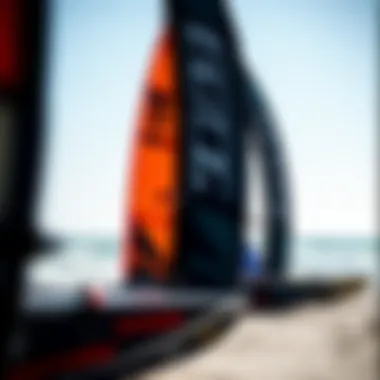
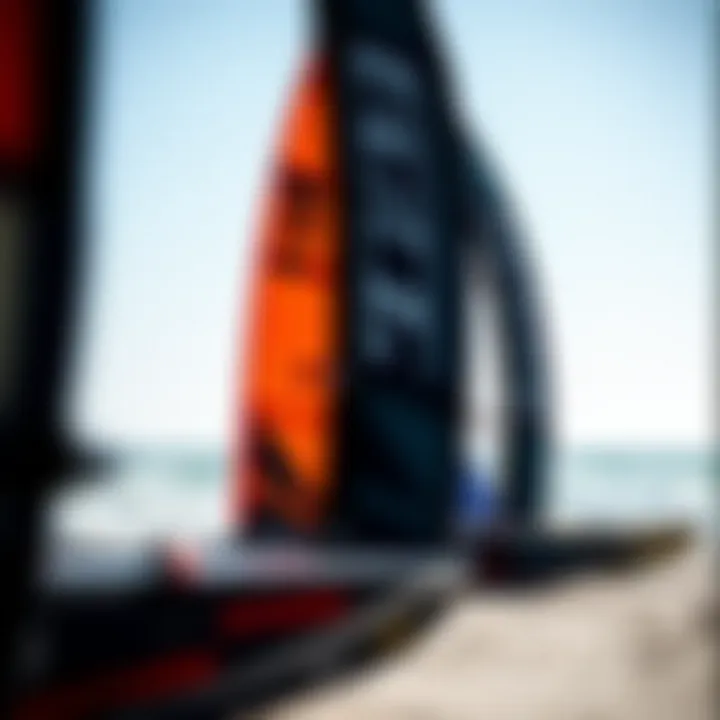
Maintenance and Care
Proper maintenance and care of kiteboarding wings cannot be overstated. It often determines the lifespan and performance of your gear. Treating your wings with care translates directly into enhanced performance, safety, and ultimately, enjoyment on the water. Just like any sporting equipment, the love you put into maintenance reflects in your experiences. Regular upkeep helps to prevent costly repairs down the line, ensuring that your equipment stays in top-notch condition.
Here’s a closer look at some key areas to focus on:
Cleaning and Storage Tips
Keeping your kiteboarding wings clean is essential. Saltwater, sand, and dirt can wear down materials over time, compromising the integrity of the wings.
- After each session: Rinse the wings thoroughly with fresh water to remove any salt or debris. Avoid using high-pressure hoses, as they may damage the fabric and seals.
- Drying: Allow your wings to air dry completely before storing them. This helps prevent mildew, which can not only damage the fabric but also affects performance.
- Storage: Store wings in a cool, dry place, away from direct sunlight. UV rays can degrade the materials, so consider using a protective bag. Hanging is often better than folding, as it avoids creases that can weaken the structure over time.
By following these steps, you ensure that your kiteboarding wings remain in prime condition, ready for your next adventure.
Repairing Minor Damages
Even with regular maintenance, accidents can happen. Cuts and abrasions are part and parcel of kiteboarding, but minor damages don't have to spell the end of your equipment. Here’s what you can do:
- Identify the Damage: Regularly check your wings for any signs of wear or tears. Fixing them early can save you money and hassle later.
- DIY Repairs: Use a kite repair kit, which usually includes patches, adhesives, and basic tools. For small rips, applying a patch on both sides of the fabric can reinforce the area. Always clean the surface before applying any adhesive to ensure a good bond.
- Professional Help: For larger tears or complex damages, seeking professional repair is often the best route. They usually have the skills and tools to effectively restore your wings to their original condition.
By addressing minor damages promptly, you not only prolong the life of your wings but also improve safety on the water.
"An ounce of prevention is worth a pound of cure." Staying ahead of maintenance and repairs keeps you flying high without interruption.
Advancements in Wing Technology
The realm of kiteboarding is no stranger to innovation, and advancements in wing technology have played a pivotal role in shaping the experience of riders around the globe. Kiteboarding wings have come a long way since their inception, and understanding these developments can greatly inform purchasing choices as well as riding experiences. The continual evolution of materials, design, and technology results not only in enhanced performance but also improves the ease of use and safety for all skill levels.
In recent years, manufacturers have made significant strides. One key area of improvement is in materials used for wing construction. Fabrics such as ripstop nylon and polyester have been combined with advanced coatings, offering strength without unnecessary weight. This shifts the paradigm on performance, allowing for sturdier wings that can withstand harsher wind conditions. Improved materials mean greater durability, leading to less frequent replacements—a win-win for any kiteboarder.
Benefits of these advancements include:
- Increased lift and responsiveness: Enhanced designs facilitate a better lift-to-weight ratio, allowing riders to exploit wind conditions with more finesse.
- Safety features: Innovations like self-draining designs and user-friendly inflation systems help ensure that wings remain effective and manageable.
- Improved maneuverability: New shaping techniques allow for better control during turns and tricks.
Overall, it’s clear that advancements in wing technology are propelling the sport forward, providing riders with options that match their personalized needs and preferences.
Innovative Designs
The most striking feature of modern kiteboarding wings is their innovative designs. With every season, brands introduce modifications that reflect not just aesthetic choices, but functional enhancements.
One example of this is the emergence of strut-less wing designs. The lack of struts makes these wings lighter, resulting in easier handling and improved performance in lower wind conditions. Surfers appreciate the seamless integration of these designs that allow for more fluid movement
A notable design improvement seen in recent years is the aspect ratio of wings. High-aspect-ratio wings, which are long and narrow, typically enhance speed but require more skill to control. Meanwhile, low-aspect-ratio wings offer more draft and stability, making them ideal for beginners. Understanding these nuances allows riders to select wings that best fit their paddling style and skill level.
Key aspects to consider with innovative designs include:
- Style preferences: Riders can choose from a range of colors and styles while still maintaining performance.
- Customizability: Many brands provide options for custom wing shapes and sizes, allowing for a more tailored kiteboarding experience.
Engaging with wings designed with the latest technology puts kiteboarders ahead of the curve, as they can harness cutting-edge advancements to amplify their sessions.
Future Directions in Kiteboarding Equipment
As we look to the future, several trends are emerging that promise to further revolutionize kiteboarding equipment. One major direction focuses on sustainability. As environmental concerns take precedence around the world, manufacturers are increasingly seeking eco-friendly materials and processes. Utilizing recycled materials or bio-based fabrics could soon become commonplace, which resonates well with the values of many riders today.
Additionally, the integration of smart technology is on the rise. Features like GPS tracking and performance monitoring could soon be standard in wing designs, providing real-time data that helps riders optimize their techniques and improve skills. Imagine a wing that not only carries you across the water but right back to the beach with empirical evidence of your progression.
Lastly, the future may also see advancements in user interface and experience. Companies are exploring enhanched safety protocols and user-friendly designs that facilitate smoother transitions from beginner to advanced levels. Adapting wings for specific wind conditions, personal preferences, and rider goals will likely become a major innovation theme.
Staying informed about these trends and future developments gives riders the edge they need to remain safely at the forefront of kiteboarding.
"Adapting to technological advancements not only improves individual performance but also enriches the collective experience within the kiteboarding community."
Those committed to the sport will watch with eager anticipation as these advancements unfold, continually modifying how we interact with our environment on the water.
Ending
Kiteboarding finds itself at a fascinating crossroads of technology, sport, and community. The journey into selecting the right wings is not merely about understanding physical dimensions or aesthetic choices. It is about making informed choices that enhance both performance and enjoyment on the water. The various options available – from inflatable wings that provide the ease of handling for newcomers, to advanced foil wings that can boost an experienced rider’s capabilities – necessitate a thoughtful approach.
A well-informed decision extends beyond buying new gear. It's about comprehending the intricacies of each design and how they align with one’s personal style of riding. Beginner kiteboarders often find themselves overwhelmed by the sheer volume of information and numerous brands competing for attention. Yet, this very diversity offers a wealth of opportunities. If you know what you’re looking for, it can turn out to be a treasure hunt rather than a chore.
Key Takeaways for Kiteboarders:
- Always consider your personal skill level and riding style.
- Understand the weather and water conditions you frequent before selecting a wing.
- Research brands thoroughly; don’t just go with the popular names.
- When possible, test wings out before committing to a purchase.
Kiteboarding is a thrilling combination of wind, water, and skill that allows for unique expressions of freedom on the waves. Making the right choice in wings can translate into a more enriching experience.
By prioritizing the right equipment, kiteboarders position themselves not just for success in performance, but for a sustainable and enjoyable engagement with the sport. Investing time into understanding how wings affect your performance can significantly enhance your time on the water. In essence, embracing knowledge equips you with the tools to ride the currents of the kiteboarding world with confidence and skill.
"The journey is just as important as the destination; in kiteboarding, every wing tells a story."
Making Informed Choices
Choosing the right wings is pivotal in shaping one’s entire kiteboarding experience. There’s no one-size-fits-all here; every rider has different needs based on skill level, intended use, and environmental conditions.
- Research is Key: Websites like Reddit and Facebook have active communities where enthusiasts share their experiences and recommendations.
- In-Person Testing: If possible, attend local shops or events. Many places offer demo days where you can try various models before making a commitment.
- Understand Specs: Don't shy away from diving deep into technical specs like aspect ratios or design materials. Knowing how these elements contribute to performance can give you a competitive edge.
With the variety of wings available today, there’s no need to feel daunted. Instead, view the selection process as an adventure where informed choices pave the way for thrilling escapades on the water.
